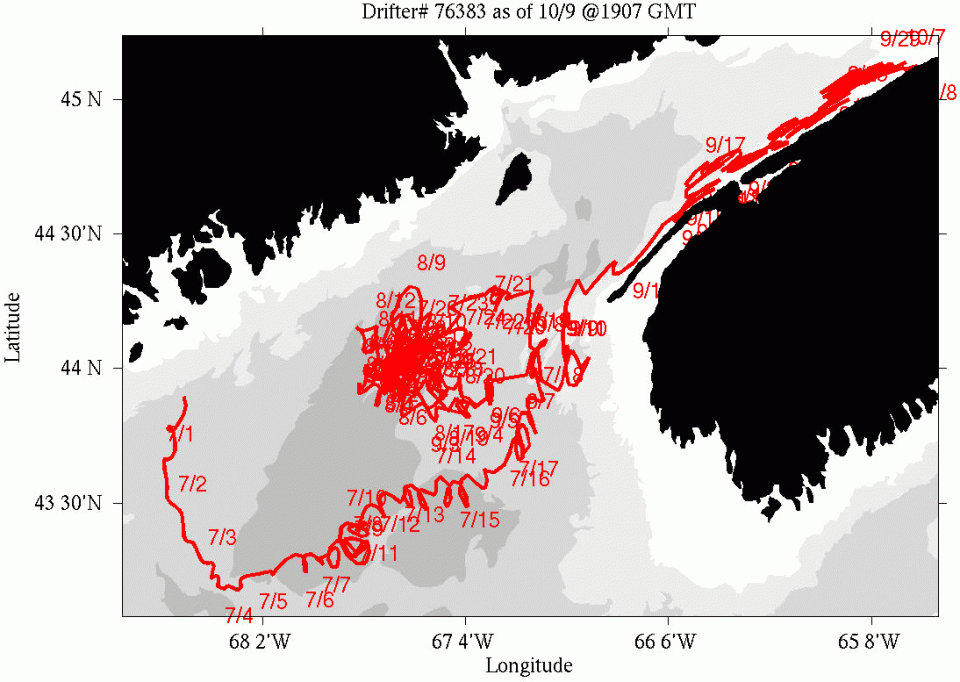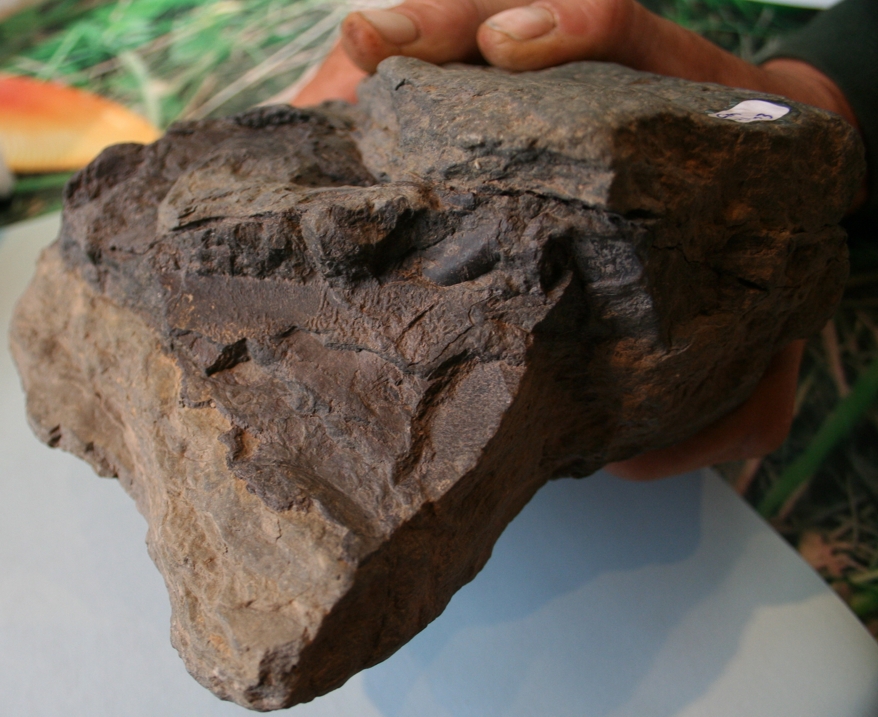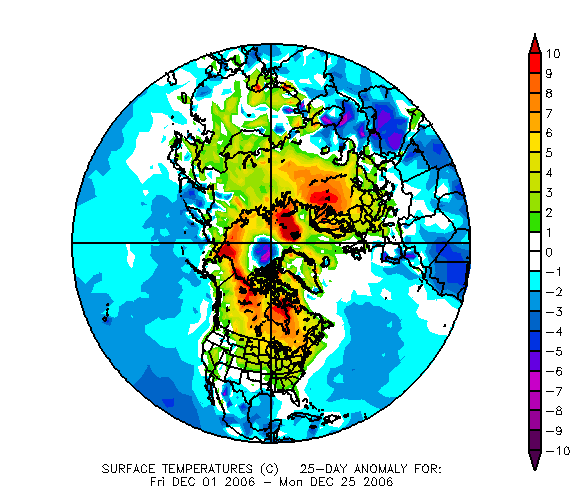Events in 2006 and 2007
Tracking a drifter
Jim Manning at the Woods Hole Oceanographic Institute called to ask if we might be willing to try to recover a beached ‘Drifter’ (a floating tracking device used for Gulf of Maine drift and current study) that was located one mile East of Bishop Mountain Road between Margaretville and Morden.
Don Osburn agreed to go hunt it on the afternoon of 9 October (the tide was right), especially since Jim made an offer of giving a talk later when coming to pick the device up. The Bishop Mountain area is one of the longer stretches of uninhabited coast, and the device, looking like a large box kite, was found exactly where he told us, on one of the most rugged stretches of Fundy coast that Don had ever been on. Upon its retrieval, Jim was delighted. He had not been receiving location updates because the unit was inside since being found, and after detaching the head and placing it outside, we received confirmation from Jim and the map of the track of this particular drifter. You can see it floated from the coast of Maine into a gyre at the mouth of the Bay of Fundy, before detaching itself and continuing along the North Mountain coast to Margaretville.

[Click on map for larger image] See http://www.nefsc.noaa.gov/drifter/ for more information on the research.
Possible Tetrapod skull discovered at Blue Beach
Reported by Chris Mansky (Blue Beach Museum): "Saturday, 6 PM, I found an articulated skull! Eureka…it looks more like a tetrapod than a rhizodont!
The fossil has some crush and displacement, but appears to include quite a lot of the skull. It shows numerous dermal cranial bones, including what appears to be an internal view of the skull roof bones, with some minor ‘molds’ where parts of the bone is missing. Much of the skull is encased in matrix and not yet available for comment. The matrix is a greenish mudstone that we associate with an infringing marsh facies – an extremely near-terrestrial environment. The soft matrix will be easy to prepare, and there is a good boundary-layer. Some of one jaw must also be present because several small teeth are seen in cross-section near what I take to be the snout'. Overall, the specimen measures about 17 long by 11 wide centimeters, but it is difficult to say at this point what the true dimensions of the skull might be.
We have waited a long time for this one...Blue Beach just became a MAINSTREAM SITE. This skull is the most important fossil ever found on this beach, and probably the most significant discovery in NS for more than a decade, if not a century! Romer’s Gap has finally relented on
its silence.

Image provided by Chris Mansky. Most of the exposed part of the fossil is broken bone sufaces which are heavily weathered. The portion seen in this view looks like the skull roof in ventral aspect, and consists mostly of near-complete bones, but has broken away at the posterior end to show a granular external ornament in the form of a natural mold. The bones are apparently about as thick as a Canadian 1$ coin, and nowhere do they thin to the degree seen in rhizodont cranial material collected from the site. The thickness of the bones, and their small size overall, gives this crushed specimen a strong tetrapod feel to it.
26 September 2007
Sumatran earthquakes
A large magnitude 8.4 earthquake rattled the Sunda arc subduction zone west of Sumatra on 12 September 2007. The first major shock happened in the evening in Sumatra, being received here at 11.30 UT (8.30 a.m.). While the first arrivals of the P-waves are impressive on the Acadia seismograph , the later surface waves have even higher amplitude.
Notice the surface waves reached their maximum about an hour after the P-waves. Later aftershocks have a similar pattern - the 7.8 aftershock just after midnight (UT) and the 7.1 aftershock at 03.55 UT are both followed by surface waves about an hour later.

[Click on graph for larger version.]
First motion studies on these earthquakes reveal typical thrust-type accretionary prism movements, with up to
4 m of displacement along the fault zones.
13 September 2007
Earthquake in Taiwan
Two major earthquakes were picked up on our seismograph in Huggins on Boxing Day - both occurred just off the southern tip of Taiwan, at magnitudes of 7.0 and 7.1. Sitting at a re-entrant in the eastern margin of the Eurasian Plate, where the Philippine Sea Plate is subducting beneath it, Taiwan is an island with frequent earthquakes, and most reports appear to indicate relatively little damage from this pair. These events were very shallow (at about 5 km), hence the large magnitude was limited to a fairly small area. They were classic low-angle thrust fault movements, typical of an accretionary prism (see the USGS page for detailed information). Interestingly, Taiwan is in the P-wave shadow zone from Nova Scotia, so only the the long waves were picked up by our seismograph.
28 December 2006
A green Christmas in Wolfville
In common with much of North America and Europe, the Valley experienced balmy weather at Christmas, prompting many to wonder again if this is global warming. While it's impossible to link any one weather event to a long term trend (just ask residents of storm-whipped Vancouver or snow-covered Denver!) the prevalence of mild late autumn and early winter weather appears to be typical of the past several years. This map from NOAA shows the Northern Hemisphere temperature anomaly for December (click on map for larger version):

Even a casual glance shows large areas of orange and red - temperatures more than 6°C above average. The result is little snow across southern Canada, ski-hills in the Alps not yet open, bare ground in Red Square, and autumn crocuses still blooming in my garden on Boxing Day.
In his WunderBlog, climatologist Jeff Masters postulates several reasons for this anomalously warm December: a moderately strong El Niño is happening, which adds heat from the Pacific Ocean to the atmosphere; the jet stream has remained relatively zonal (no big loops) preventing cold Arctic air from being pumped south; the past decade or more of warming in the Arctic has melted about 10-15% of the ice-pack, exposing warmer ocean water, which in turns is heating the Arctic; and over the past 30 years, the planet has warmed by about 0.5° overall. The combination of all these effects results in a higher likelihood for a mild winter this year.
27 December 2006
